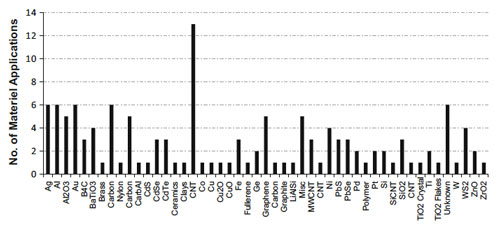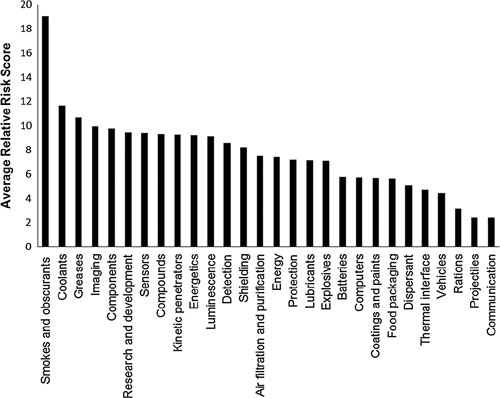| Posted: Jan 06, 2015 | |
A risk-ranking tool for nanomaterials used by the military |
|
| (Nanowerk Spotlight) Military organizations around the world, especially in the U.S., have been quicker than most to appreciate the potential of nanotechnology. More money is being spent on nanotechnology research for military applications than for any other area (read more: Military nanotechnology - how worried should we be?). | |
| Public releases about military nanotechnology research and development activities are full about sensors, batteries, wound care, filtration systems, smart fabrics, and lighter, stronger, heat-resistant nanocomposite materials etc. Naturally, nanomaterial safety has become an important issue for military organizations as well. | |
| "Assessing the potential human health and environmental risks of engineered nanomaterials (ENMs) within the context of the applications and products in which they are incorporated continues to be an extremely challenging endeavor,"Khara D. Grieger, PhD, an Environmental Risk Assessor and research scientist at RTI International, tells Nanowerk. "Given the challenges of developing sufficient data that would be required for traditional risk assessment frameworks, risk assessors are continuing to refine their methods and techniques to perform risk assessments using combined quantitative and qualitative frameworks for ENMs, resulting in various alternatives for risk analysis." | |
| The use of risk ranking tools may be particularly advantageous to prioritize materials or products according to their risk potential, i.e., identify the 'riskiest' ENMs or nanotechnology products, for example, for further research or investigation. This may be useful especially in cases of resource and time constraints. | |
| Based on the research conducted by the U.S. Army Center for Environmental Health Research (USACEHR) associated with the incorporation of various engineered nanomaterials into military applications and equipment (termed Army materiel), a new analysis develops and implements a risk ranking tool to rank ENM–Army materiel pairs based on their relative risks to soldier and civilian health under occupational scenarios. | |
| The analysis included 133 unique applications and shows a wide range of nanomaterials used: | |
 |
|
| ©Springer Science+Business Media (click on image to enlarge) | |
| A paper on this research, first-authored by Grieger, has just been published in Environment Systems & Decisions ("A relative ranking approach for nano-enabled applications to improve risk-based decision making: a case study of Army materiel"). | |
| The scientific core of the paper focuses on the development and application of a relative risk ranking tool that ranks engineered nanomaterials as well as the applications in which they are embedded (in this case, Army materiel) relevant for worker or soldier health. | |
| "The development of this tool is important because it not only takes into account the physicochemical characteristics of ENMs but also the characteristics of the equipment in which they are embedded, relevant for current, real-world scenarios involving ENMs," explains Grieger. "The results from this work may be used to help prioritize additional research, such as in-depth risk evaluations or further nanotoxicological research pertaining to the highest ranked ENMs, materiel, or ENM–materiel pairs." | |
| She adds that the fundamental methodology and risk ranking algorithm developed in the ranking tools may be applicable to other occupational and environmental settings involving ENMs and therefore easily translated to other application scenarios. | |
| Grieger also points out that this study is unique in that real world ENM–Army material pairs used in research or full scale field applications were considered to perform the relative risk ranking rather than primarily hypothetical or pristine ENMs. It is also unique since a tool was developed for a specific organization or stakeholder, so it was able to be tailored to meet their needs more precisely. | |
| The result of this study came up with these average relative risk scores across Army materiel: | |
 |
|
| ©Springer Science+Business Media (click on image to enlarge) | |
| This paper demonstrates the application of a risk ranking tool for Army materiel which contains ENMs. However, the fundamental methodology and risk ranking algorithm developed in the ranking tools may be applicable to other occupational and environmental settings involving ENMs and therefore easily translated to other application scenarios. | |
| "Ideally, it is recommended that future revisions of this ranking tool and other similar tools involving ENMs be able to tap into publicly accessible databases in order to be able to update the underlying data sets on environmental, health and safety implications of ENMs, potentially in real time," says Grieger. "As significant research efforts are currently focused on the collection and curation of data on ENMs and their behavior, these risk ranking tools would benefit from accessing these publicly accessible databases." | |
| Separate analyses that assess 'new' levels of uncertainty if additional data were required, such as Value of Information methodologies, may also be beneficial when considering such updates based on current knowledge. | |
| The paper's authors also recommended that increased funding is made available to support the development of decision support tools for emerging technologies, including those focused on risk ranking, which specialize in conditions of extreme uncertainty. | |
| "Given the ever-increasing pace of nanomaterial development and incorporation into various product applications as well as the extreme challenges to develop the data required to satisfy quantitative risk assessment approaches, decision support frameworks which focus on handling extreme conditions of uncertainty in a transparent, structured, and robust manner are critically needed, particularly for decisions regarding emerging technologies in the twenty-first century," Grieger concludes. | |
 By
Michael
Berger
– Michael is author of three books by the Royal Society of Chemistry:
Nano-Society: Pushing the Boundaries of Technology,
Nanotechnology: The Future is Tiny, and
Nanoengineering: The Skills and Tools Making Technology Invisible
Copyright ©
Nanowerk LLC
By
Michael
Berger
– Michael is author of three books by the Royal Society of Chemistry:
Nano-Society: Pushing the Boundaries of Technology,
Nanotechnology: The Future is Tiny, and
Nanoengineering: The Skills and Tools Making Technology Invisible
Copyright ©
Nanowerk LLC
|
|
|
Become a Spotlight guest author! Join our large and growing group of guest contributors. Have you just published a scientific paper or have other exciting developments to share with the nanotechnology community? Here is how to publish on nanowerk.com. |
|
